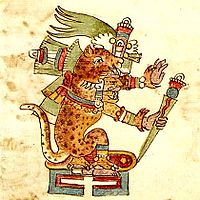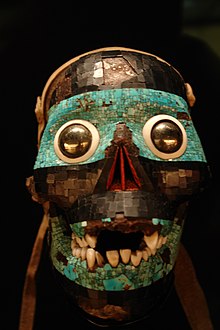This is an old revision of this page, as edited by 142.22.186.7 (talk) at 21:52, 2 February 2009 (→Mythical stories). The present address (URL) is a permanent link to this revision, which may differ significantly from the current revision.
Revision as of 21:52, 2 February 2009 by 142.22.186.7 (talk) (→Mythical stories)(diff) ← Previous revision | Latest revision (diff) | Newer revision → (diff)
Tezcatlipoca (Template:Lang-nci IPA: [tes.ka.tɬi.ˈpoː.ka]) was a central deity in Aztec religion, associated with a wide range of concepts including the night sky, the night winds, hurricanes, the north, the earth, obsidian, enmity, discord, rulership, divination, temptation, sorcery, beauty, war and strife. His name in the Nahuatl language is often translated as "Smoking Mirror" and alludes to his connection to obsidian, the material from which mirrors were made in Mesoamerica and which was used for shamanic rituals.
He had many epithets which alluded to different aspects of his deity: Titlacauan ("We are his Slaves"), Ipalnemoani ("He by whom we live"), Necoc Yaotl ("Enemy of Both Sides"), Tloque Nahuaque ("Lord of the Near and the Nigh") and Yohualli Èecatl ("Night, Wind"), Ome acatl ("Two Reed"), Ilhuicahua Tlalticpaque ("Possessor of the Sky and Earth").
When depicted he was usually drawn with a black and a yellow stripe painted across his face. He is often shown with his right foot replaced with an obsidian mirror or a snake - an allusion to the creation myth in which he loses his foot battling with the Earth Monster. Sometimes the mirror was shown on his chest, and sometimes smoke would emanate from the mirror. Tezcatlipoca's nagual, his animal counterpart, was the jaguar and his jaguar aspect was the deity Tepeyollotl ("Mountainheart"). In the Aztec ritual calendar the Tonalpohualli Tezcalipoca ruled the trecena 1 Ocelotl ("1 Jaguar") - He was also patron of the days with the name Acatl ("reed").
The Tezcatlipoca figure goes back to earlier Mesoamerican deities worshipped by the Olmec and Maya. Similarities exist with the patron deity of the K'iche' Maya as described in the Popol Vuh. A central figure of the Popol Vuh was the god Tohil whose name means "obsidian" and who was associated with sacrifice. Also the Classic Maya god of rulership and thunder known to modern Mayanists as "God K", or the "Manikin Scepter" and to the classic Maya as K'awil was depicted with a smoking obsidian knife in his forehead and one leg replaced with a snake.
Tezcatlipoca and Quetzalcoatl
Tezcatlipoca was often described as a rival of another important god of the Aztecs, the culture hero, Quetzalcoatl. In one version of the Aztec creation account the myth of the Five Suns, the first creation, "The Sun of the Earth" was ruled by Tezcatlipoca but destroyed by Quetzalcoatl when he struck down Tezcatlipoca who then transformed into a jaguar. Quetzalcoatl became the ruler of the subsequent creation "Sun of Water", and Tezcatlipoca destroyed the third creation "The Sun of Wind" by striking down Quetzalcoatl.

In later myths, the four gods who created the world, Tezcatlipoca, Quetzalcoatl, Huitzilopochtli and Xipe Totec were referred to respectively as the Black, the White, the Blue and the Red Tezcatlipoca. The four Tezcatlipocas were the sons of Ometecuhtli and Omecihuatl, lady and lord of the duality, and were the creators of all the other gods, as well as the world and all humanity.
The rivalry between Quetzalcoatl and Tezcatlipoca is also recounted in the legends of Tollan where Tezcatlipoca deceives Quetzalcoatl who was the ruler of the legendary city and forces him into exile. But it is interesting to note that Quetzalcoatl and Tezcatlipoca both collaborated in the creation of the different creations and that both of them were seen as instrumental in the creation of life. Karl Taube and Mary Miller, specialists in Mesoamerican religion, writes that "More than anything Tezcatlipoca appears to be the embodiment of change through conflict." Tezcatlipoca appears on the first page of the Codex Borgia carrying the 20 day signs of the calendar; in the Codex Cospi he is shown as a spirit of darkness, as well as in the Codex Laud and the Dresden Codex. His cult was associated with royalty, and was the subject of the most lengthy and reverent prayers in the rites of kingship, as well as being mentioned frequently in coronation speeches. The temple of Tezcatlipoca was in the Great Precinct of Tenochtitlan.
Aztec religion
The Main temple of Tezcatlipoca in Tenochtitlan was located south of the Great Temple. According to Fray Diego Durán it was "lofty and magnificently built. Eighty steps led to a landing twelve or fourteen feet wide. Beyond it stood a wide, long chamber the size of a great hall..." There were several smaller temples dedicated to Tezcatlipoca in the city, among them the ones called "Tlacochcalco" and "Huitznahuatl". Tezcatlipoca was also worshipped in many other Nahua cities such as Texcoco, Tlaxcala and Chalco. Each temple had a statue of the god for which copal incense was burned four times a day. There were several priests dedicated to the service of Tezcatlipoca, one of them was probably the one Sahagún calls "huitznahuac teohua omacatl", others were the calmeca teteuctin who were allowed to eat the ritual food offered to Tezcatlipoca, others accompanied the Ixiptlatli impersonator of Tezcatlipoca in the year prior to his execution. Tezcatlipocas priests were offered into his service by their parents as children, often because they were sick. These children would then have their skin painted black be adorned with quail feathers in the image of the god.
Tezcatlipoca’s main feast was during Toxcatl, the fifth month of the Aztec calendar. The preparations began a year earlier, when a young man was chosen by the priests, to be the likeness of Tezcatlipoca. For the next year he lived like a god, wearing expensive jewellery and having eight attendants. He would marry four young women, and spent his last week singing, feasting and dancing. During the feast where he was worshipped as the deity he personified he climbed the stairs to the top of the temple on his own where the priests seized him and sacrificed him, his body being eaten later. Immediately after he died a new victim for the next year’s ceremony was chosen. Tezcatlipoca was also honoured during the ceremony of the 9th month, when the Miccailhuitontli "Little Feast of the Dead" was celebrated to honour the dead, as well as during the Panquetzaliztli "Raising of Banners" ceremony in the 15th month.

Mythical stories
nom
Notes
- The vowel transliterated here as may in fact have been long or followed by a glottal stop which is sometimes written as an <h>
- For a discussion of the many interpretations of the meaning of the name Tezcatlipoca see Olivier (2003) pp. 14-15.
- This name which is derived from his birthdate in the Aztec "2 Reed" which is the first date in the Aztec year is sometimes also spelled Omacatl
- For a summary of Tezcatlipocas epithets and their siginificance see Olivier (2003) Chapter 1.
- Taube & Miller 1993 p. 164
- Jun Raqan "the one-legged" was an epithet of this Classic Maya Deity of rulership and thunder which eventually lead to the English word "Hurricane".
- The Version as it is recounted in the Codex Ramirez - also called "Historia de Los mexicanos por sus Pinturas". Full text of this Codex in English translation can be found at FAMSI
- Taube & Miller 1993 p. 164
- Durán quoted from Olivier (2003) p. 166
- For an in depth description and interpretation of the Toxcatl festival see Olivier (2003) Chapter 6.
References
- Miller, Mary (1993). The Gods and Symbols of Ancient Mexico and the Maya. London: Thames and Hudson. ISBN 0-500-05068-6.
{{cite book}}: Unknown parameter|coauthors=ignored (|author=suggested) (help); templatestyles stripmarker in|author=at position 1 (help); templatestyles stripmarker in|coauthors=at position 5 (help)CS1 maint: numeric names: authors list (link) - Olivier, Guilhem (2003). Mockeries and Metamorphoses of an Aztec God - Tezcatlipoca, "Lord of the Smoking Mirror". Translated by Michel Besson. University Press of Colorado. ISBN 0-87081-745-0.
{{cite book}}: templatestyles stripmarker in|author=at position 1 (help)CS1 maint: numeric names: authors list (link)